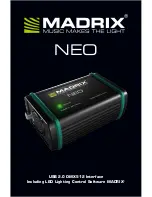
KĆ18
K3.0 DIAGNOSTICS AND
TROUBLESHOOTING
This section describes how to troubleshoot the fiberĆoptic Remote
I/O network and its components. Refer to section 6.0 of this manual
for troubleshooting procedures for the Remote I/O module, the
Remote I/O Head, Remote Drive Interface Head, and the Shark
Interface module.
DANGER
ONLY QUALIFIED ELECTRICAL PERSONNEL FAMILIAR WITH THE
CONSTRUCTION AND OPERATION OF THIS EQUIPMENT AND THE
HAZARDS INVOLVED SHOULD INSTALL, ADJUST, OPERATE, AND/OR
SERVICE THIS EQUIPMENT. READ AND UNDERSTAND THIS MANUAL IN ITS
ENTIRETY BEFORE PROCEEDING. FAILURE TO OBSERVE THIS
PRECAUTION COULD RESULT IN SEVERE BODILY INJURY OR LOSS OF
LIFE.
K3.1
Network Failure
Problem: Error code C appears on any Remote I/O module's LED
display. This error code indicates a network failure. Read section 6.3
of this manual and follow step 1Ć4 before continuing with the
procedure described below. The following procedure is used to
isolate the cause of a network failure by systematically checking the
hardware components that make up a pointĆtoĆpoint fiberĆoptic link.
After each step, determine if the problem has been corrected before
continuing to the next step.
Step 1.
Verify that the connections are secure between the drop
faceplate and the StandĆAlone Transceiver. (Depending
upon the application, this will require checking the drop
cable or the Tee Adapter and balun connections.) Verify
that its connections to the StandĆAlone Transceiver's
terminal block are secure and correct as shown in figure
K2.2.
Step 2.
Check the StandĆAlone Transceiver. Using a voltmeter,
verify that the power supply voltage is within normal
limits. Verify that the fiberĆoptic cable connections are
secure. Note that the LEDs on the transceiver will flicker
to indicate that the transceiver is sending/receiving
messages. Verify that the jumper is securely connected
between terminals 3 and 4. Replace the transceiver.
Step 3.
Check the fiberĆoptic cable. Verify that the cable has not
been damaged due to improper handling (e.g., bending it
beyond the minimum bend radius). Test the cable using a
fiberĆoptic power meter or a fiberĆoptic time domain
reflectometer (OTDR). The recommended cable
assembly test set is listed in Appendix F. Replace the
cable.
Step 4.
Remove the plastic panel from the front of the FiberĆOptic
Rack, and check the corresponding RackĆMounted
Transceiver.
Содержание AutoMax 57C328
Страница 1: ......
Страница 7: ...VI Figure 5 1 Drop Status Monitoring 5 1 Figure 6 1 AutoMax Rail Fault LED Codes 6 5...
Страница 14: ...fafadfdfdasfdsfdsdsdfdsfdsfdsfsdfdsa afdfdsfdsfdfdsfdsfsadfda asfdfaddfdd...
Страница 16: ......
Страница 47: ...4 0 4 0 0 2 0 0 0 0 0 0 2 2 0 0 0 0 0 1 0 0 3 0 0 4 1 2 0 0 0 2 1 2 2 0 4 0 0 0 0 0...
Страница 70: ......
Страница 84: ...fafadfdfdasfdsfdsdsdfdsfdsfdsfsdfdsa afdfdsfdsfdfdsfdsfsadfda asfdfaddfdd...
Страница 97: ...Appendix B Block Diagrams Remote I O Communications Module M N 57C416 0 3...
Страница 99: ...Appendix B Remote I O Head M N 57C328 and M N 57C330...
Страница 100: ...Appendix B Remote Drive Interface Head M N 57C329...
Страница 102: ...fafadfdfdasfdsfdsdsdfdsfdsfdsfsdfdsa afdfdsfdsfdfdsfdsfsadfda asfdfaddfdd...
Страница 104: ...fafadfdfdasfdsfdsdsdfdsfdsfdsfsdfdsa afdfdsfdsfdfdsfdsfsadfda asfdfaddfdd...
Страница 105: ...Appendix E Schematics Communications Passive Tap M N 57C380...
Страница 106: ...Appendix E Continued Fiber Optic Rack Power Supply M N 57C368...
Страница 110: ...fafadfdfdasfdsfdsdsdfdsfdsfdsfsdfdsa afdfdsfdsfdfdsfdsfsadfda asfdfaddfdd...
Страница 114: ...fafadfdfdasfdsfdsdsdfdsfdsfdsfsdfdsa afdfdsfdsfdfdsfdsfsadfda asfdfaddfdd...
Страница 118: ...0 0 0 0 0 0 0 0 0 0 0 0 0 0 0 0 0 0 0 0 0 0 0 0 0 0 0 0 0 0 0 0...
Страница 142: ......
Страница 143: ...fafadfdfdasfdsfdsdsdfdsfdsfdsfsdfdsa afdfdsfdsfdfdsfdsfsadfda asfdfaddfdd...









































